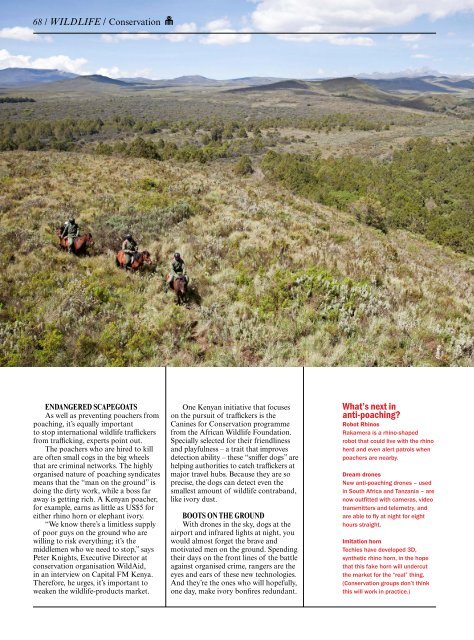You also want an ePaper? Increase the reach of your titles
YUMPU automatically turns print PDFs into web optimized ePapers that Google loves.
68 / WILDLIFE / Conservation<br />
Alamy<br />
ENDANGERED SCAPEGOATS<br />
As well as preventing poachers from<br />
poaching, it’s equally important<br />
to stop international wildlife traffickers<br />
from trafficking, experts point out.<br />
The poachers who are hired to kill<br />
are often small cogs in the big wheels<br />
that are criminal networks. The highly<br />
organised nature of poaching syndicates<br />
means that the “man on the ground” is<br />
doing the dirty work, while a boss far<br />
away is getting rich. A Kenyan poacher,<br />
for example, earns as little as US$5 for<br />
either rhino horn or elephant ivory.<br />
“We know there’s a limitless supply<br />
of poor guys on the ground who are<br />
willing to risk everything; it’s the<br />
middlemen who we need to stop,” says<br />
Peter Knights, Executive Director at<br />
conservation organisation WildAid,<br />
in an interview on Capital FM Kenya.<br />
Therefore, he urges, it’s important to<br />
weaken the wildlife-products market.<br />
One Kenyan initiative that focuses<br />
on the pursuit of traffickers is the<br />
Canines for Conservation programme<br />
from the African Wildlife Foundation.<br />
Specially selected for their friendliness<br />
and playfulness – a trait that improves<br />
detection ability – these “sniffer dogs” are<br />
helping authorities to catch traffickers at<br />
major travel hubs. Because they are so<br />
precise, the dogs can detect even the<br />
smallest amount of wildlife contraband,<br />
like ivory dust.<br />
BOOTS ON THE GROUND<br />
With drones in the sky, dogs at the<br />
airport and infrared lights at night, you<br />
would almost forget the brave and<br />
motivated men on the ground. Spending<br />
their days on the front lines of the battle<br />
against organised crime, rangers are the<br />
eyes and ears of these new technologies.<br />
And they’re the ones who will hopefully,<br />
one day, make ivory bonfires redundant.<br />
What’s next in<br />
anti-poaching?<br />
Robot Rhinos<br />
Rakamera is a rhino-shaped<br />
robot that could live with the rhino<br />
herd and even alert patrols when<br />
poachers are nearby.<br />
Dream drones<br />
New anti-poaching drones – used<br />
in South Africa and Tanzania – are<br />
now outfitted with cameras, video<br />
transmitters and telemetry, and<br />
are able to fly at night for eight<br />
hours straight.<br />
Imitation horn<br />
Techies have developed 3D,<br />
synthetic rhino horn, in the hope<br />
that this fake horn will undercut<br />
the market for the “real” thing.<br />
(Conservation groups don’t think<br />
this will work in practice.)

















